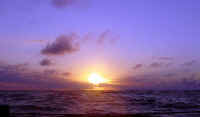March 29 (140 nautical miles)
In the stillness of the morning, a helicopter appeared out of
nowhere, it’s presence first made known by its thundering vibration
piercing the peacefulness of the day. From what we could tell, with
the skull and crossbones on its side, it looked like a US military
chopper. Very intimidating as it hovered so close to us that we
could see the faces of the military personnel looking down on us,
one of them taking pictures. They circled us several times and when
we attempted to contact them, they did not respond. We waved but
they didn't wave back. At one point the turbulence from the chopper
almost caused our boat to broach as the 100-knot wind created by
them filled our sail and hit us broadside. Later someone in the
fleet suggested that they were only looking for bare breasted women! |

March 30
(109 nautical miles)
The wind has remained settled at around 12-15 knots for a couple of
days and we are sailing under our spinnaker averaging about 6.5 to 7
knots. We were delighted when a huge group of spotted dolphins came
to visit for a while. They darted under the boat and challenged each
other in some sort of game involving our bow wave. You could easily
watch their antics through the crystal clear water, which was the
most amazing color of indigo blue. |
What amazes me is the constant flock of birds, boobies and terns,
circling the boat. They seem very curious and just hang around, way
out here. The boobies are always trying to spot a place to land and
hitch a ride. A Boobie flew right into our wind generator, knocked
himself out, rolled down the bimini and landed on the side deck with
a thud. He woke up and was staring right in at me through the open
port light where I was trying to nod off in the aft cabin. Gave me
quite a start! |
 After
seeing no one for days, amazingly enough we met up with
Emerald out there in mid ocean. It was a fun rendezvous, as
we took pictures of each other's boats sailing under spinnaker. It
was a real treat to have someone to converse with again for a while.
Pictured right is Ascension under spinnaker. After
seeing no one for days, amazingly enough we met up with
Emerald out there in mid ocean. It was a fun rendezvous, as
we took pictures of each other's boats sailing under spinnaker. It
was a real treat to have someone to converse with again for a while.
Pictured right is Ascension under spinnaker.
|
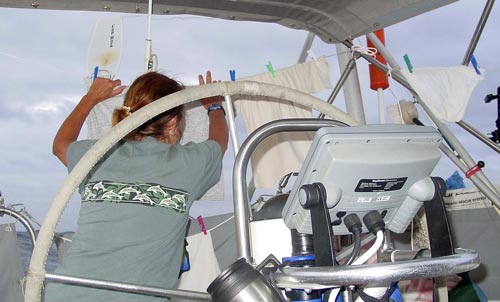
|
March 31
(111 nautical miles)
We both tried to catch up on sleep today without any luck. It's just
so hot and there is so much movement. It's hard to stay put on the
bunk. Not as bad as the first couple of days out but I must say I
feel like I am on one of those Mad-Hatter Tea Cup Carnival rides.
Daily routines of cooking and doing laundry are difficult and take a
lot more energy than you would imagine.
|
 We
are trying to do 3 hour watches at night and a less regimented
schedule during the day. Every 8 minutes or so I check the horizon
and radar for that illusive white flicker of light that verifies
that I'm not the only one left on earth. However, I have not seen
even the merest pinprick of light or signs of a vessel for days and
nights. We are out in front of the fleet that we had been conversing
with, including Matarua, who is 75 miles behind us
now. We are out of range of VHF radio contact that gave conversation
and company during the night. The radio is silent, not even any
Mexican fishermen, ships or anyone. We
are trying to do 3 hour watches at night and a less regimented
schedule during the day. Every 8 minutes or so I check the horizon
and radar for that illusive white flicker of light that verifies
that I'm not the only one left on earth. However, I have not seen
even the merest pinprick of light or signs of a vessel for days and
nights. We are out in front of the fleet that we had been conversing
with, including Matarua, who is 75 miles behind us
now. We are out of range of VHF radio contact that gave conversation
and company during the night. The radio is silent, not even any
Mexican fishermen, ships or anyone.
|
 My
shift over, it's time for the first net of the day, and we
look forward to hearing familiar voices check in. Just before tuning
up the ham radio, Gord usually does a sweep around the deck to clear
off all the flying fish and squid that accumulate during the
night. My
shift over, it's time for the first net of the day, and we
look forward to hearing familiar voices check in. Just before tuning
up the ham radio, Gord usually does a sweep around the deck to clear
off all the flying fish and squid that accumulate during the
night.
Flying fish all around, hundreds of them, all
taking to the air at once as we approached. They can even get
enough altitude to get as high as the deck, and when they get going
they can easily cover a hundred yards or even more in distance flown
. Last night, Gord was smacked upside the head in the total
darkness by a huge flying fish, about 10 inches long. It left a
greasy smear of fish scales down the side of his face! A flying fish
even somehow managed to torpedo itself between the bimini window and
the canvas cover, which is a very tight fit! We had to take the
cover completely off to get the critter out. |
Speaking of sea life, the bottom of Ascension has
become a farm for a thick green slime that covers the waterline.
Around the transom and rudder is a crop of gooseneck barnacles that
flourish at an amazing rate. Some of them are well over an inch
long. I am told that these barnacles only attach themselves to
moving objects and will fall off naturally when we are at anchor. We
will see.
|

April 1 (130 miles)
At 5 pm today, we celebrated the conclusion of our first week
offshore. We have traveled 860 miles with an average daily distance
of 120 miles. However, we still are not looking at our position on
the chart in relationship to how far we still have to go because it
would be too daunting. |
We were feeling quite settled about the passage with good speed,
still under spinnaker and a moderately comfortable ride. But
suddenly an unexpected 20 knot gust twisted the boat and slewed
us down the backside of a wave back-winding the spinnaker. When
the sail filled again, there was an enormous whommmph! as it
exploded into a dozen pieces. I guess I should have made a more
ceremonious effort to pay homage to Davy Jones as we left PV. |
Luckily since losing our spinnaker, we've had 20 knot winds
consistently which keeps our speed up. Unfortunately, the ride
turned rough again and I am getting tossed around the cabin like a
rag doll. Had peanut butter sands for lunch & supper. Glad we didn't
catch any fish today because I couldn't have dealt with it. The
cockpit is the best place to be ...although it is 90 degrees and
similar humidity, at least there are no flying objects above deck. |
We are now way out in front of the entire group that we were
traveling with. Over 100 miles from Matarua. No more
VHF radio contact for a chat in the middle of the night. The boats
in front of us left 2 or 3 days ahead of us at least so it is
unlikely we will catch them.
|
April 2 (131 nautical miles)
Night watches can be truly mind altering. It's like riding a
comet through the night. The moon's not up yet and the dark night
sky is peppered with stars. From beneath the boat, an unbelievably
bright trail of phosphorescence streams aft. A yard wide and fifty
feet long, the glow from beneath the clear water's surface is
accented by bursts of swirling star-like plankton that announce
their awareness of our passage.
It’s like a trail of fairy dust on either side of the boat, a foamy
light show of its own.
|
April 3 (128 nautical miles)
The winds have been a good 15-20 knots all day, and our usual sail
configuration is a double reefed main with full foresail. |
Today, another group of boats left from PV, including Tackless
II and Ocean Girl. They finally got the winds
needed to get going after a week of waiting. Unfortunately, they are
so far behind now, about 1000 miles, that we can't even hear them on
the ham radio nets without a relay.
|
April 5
We jibed today to correct our course and get further south instead
of west. The course change put us behind Emerald whom
we had passed 2 days ago. The wind is blowing 27 knots, swell 12
feet and it's raining. There has been a series of squalls that we
have been going through, making night watches challenging. My keyboard flew off the nav
table onto the floor & broke. Cup a noodles was all we could muster
for supper. Am losing weight but that's okay after all the Happy
Hours in Mexico. |
We are officially half way there! Having sailed 1500 miles in the
past 11 days we have gone further than the entire trip down the West
Pacific coast. A pilot whale surfaced right beside the boat earlier
today, I’m sure in celebration of the
landmark.
|
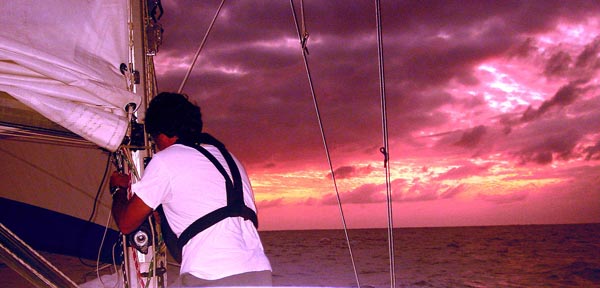 April
6 (99 nautical miles) April
6 (99 nautical miles)
Squalls bringing torrential rain continued intermittently for
several days, sucking all the wind away from our path as they
passed. Iron Jenny called into action reluctantly, but we need to
preserve our sails that have been banging and slapping around in the
swell. Black ugly angry clouds all around and lightning everywhere,
sometimes striking so close that you could smell the ozone.
Here we
are, a big lightning rod in the water. Wondering if it really does
any good to put the GPS and the computer in the oven.....Gord has
not yet figured out how to use the sextant and we hope it never
comes to that. |
Last 24 hours have been a mixed bag. Squally, torrential rains,
lightning, no wind at all, then a burst of wind that gave us a great
sail for a while. We are having trouble making a good course,
dodging storm cells and just trying to keep the boat moving forward.
Only made 99 miles in last 24 hours but that was course made good.
Who knows how far we actually sailed. |
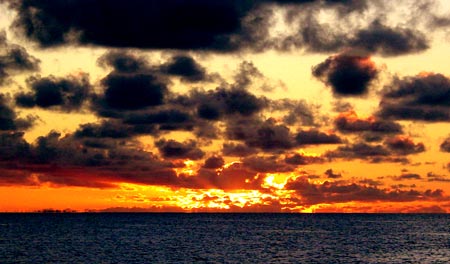 April
10 (67 nautical miles) April
10 (67 nautical miles)
The sun set on building ugly black clouds ballooning into
threatening monstrous shapes, with their entrails of rain streaking
the distance sky. By night we were hit by major squalls and
torrential downpours accompanied by lightning several times. It was
so black out and with the driving rain, you couldn't see the front
of the boat. We managed to get the sails down and we were motoring
when the 30 knots gusts hit suddenly. |
By early morning some wind finally came up so we tried to sail, but
the wind direction put us many miles off course. Since then, we have
had flat calm seas, with a 3 foot swell and no wind. We are having
to run our engine traveling at a snail's pace of 3.5 knots to try
and conserve our fuel. Today was our worst mileage ever. Supposable,
the doldrums we are in last at least 300 miles, which is a long way
to motor. |
It is stifling hot in the cabin, about 95 deg F and 2 am with the
same humidity reading. The engine running makes it worse but at
least with the calm seas we can open a hatch. Am getting use to
always being very sweaty.
|
Just did our routine check into the Pacific Seafarers net and heard
a call from a young couple approached by a Columbia ship who shone a
spotlight on them and were acting suspicious. The Net immediately
patched them in to the US Coast Guard who instructed them what to do
and tried to verify the identity of the Columbian vessel. It was
quite interesting. Good to know that the nets are available for
assistance.
|
April 11
After 2 weeks and sailing 2000 miles without seeing land, we are
getting cabin fever. The winds have kept up enough to keep us moving
along as we are trying to get to the equator before the doldrums are
predicted to set into this area. Gord and I have both been
completely dragged out. Sleep deprivation and the unbelievable
heat/humidity is very draining. It's a good thing we now have a good
watermaker because it's hard to drink enough water to combat
dehydration.
Just to get to the frig to pour a mug of water takes
tremendous effort. Our bones and muscles are so sore from the
constant "boat yoga" necessary just to stay put on your seat or bunk
or to get around the boat handrail to handrail and leaning into
whatever is handy to keep your balance. And all that cool inviting
water all around. Oh how I wish we could take a dip.
But of course
the boat is always moving and the swell is considerable so we have
no desire to get off the boat and have it sail away without us!. Our
lifejacket/tethers are designed to inflate when wet, so we wouldn't
want to waste a $60 cartridge if a jacket was activated. |
My first watch last night (from 10 am to 1 am) was under a clear
moonless night with bright stars everywhere. I took out the star
chart and tried to find some constellations. The Southern Cross
stands boldly at our bow keeping us on course. Too bad you don't see
those stars in the Western Hemisphere. By my second watch (4 am) the
sky was all cloudy and the stars were gone. |
Amazingly enough we can once again see Matarua in the
distance. After traveling thousands of miles in this huge ocean, not
having seen anyone in weeks, Matarua, who was 100
miles behind at one point, is now a dot on the horizon. We are about
6 miles apart!. That's amazing. We are still at least a week away
from land.
|
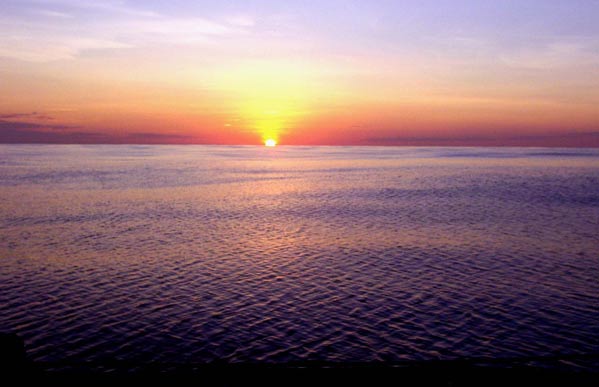
April
13 (125 nautical miles)
We were really missing the spinnaker as we motored across flat calm
glassy seas for 2 days. We were surprised that the "magic line" of 0
degrees latitude seemed to produce a breeze and before long we had
the sails back up and were clipping along at 6 knots once again. |



